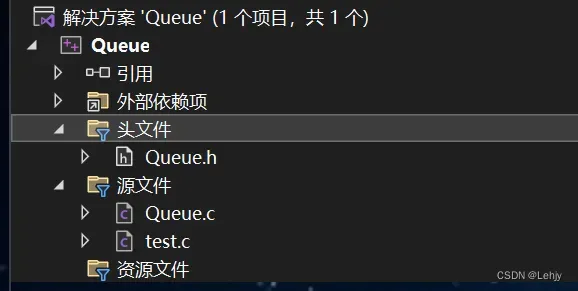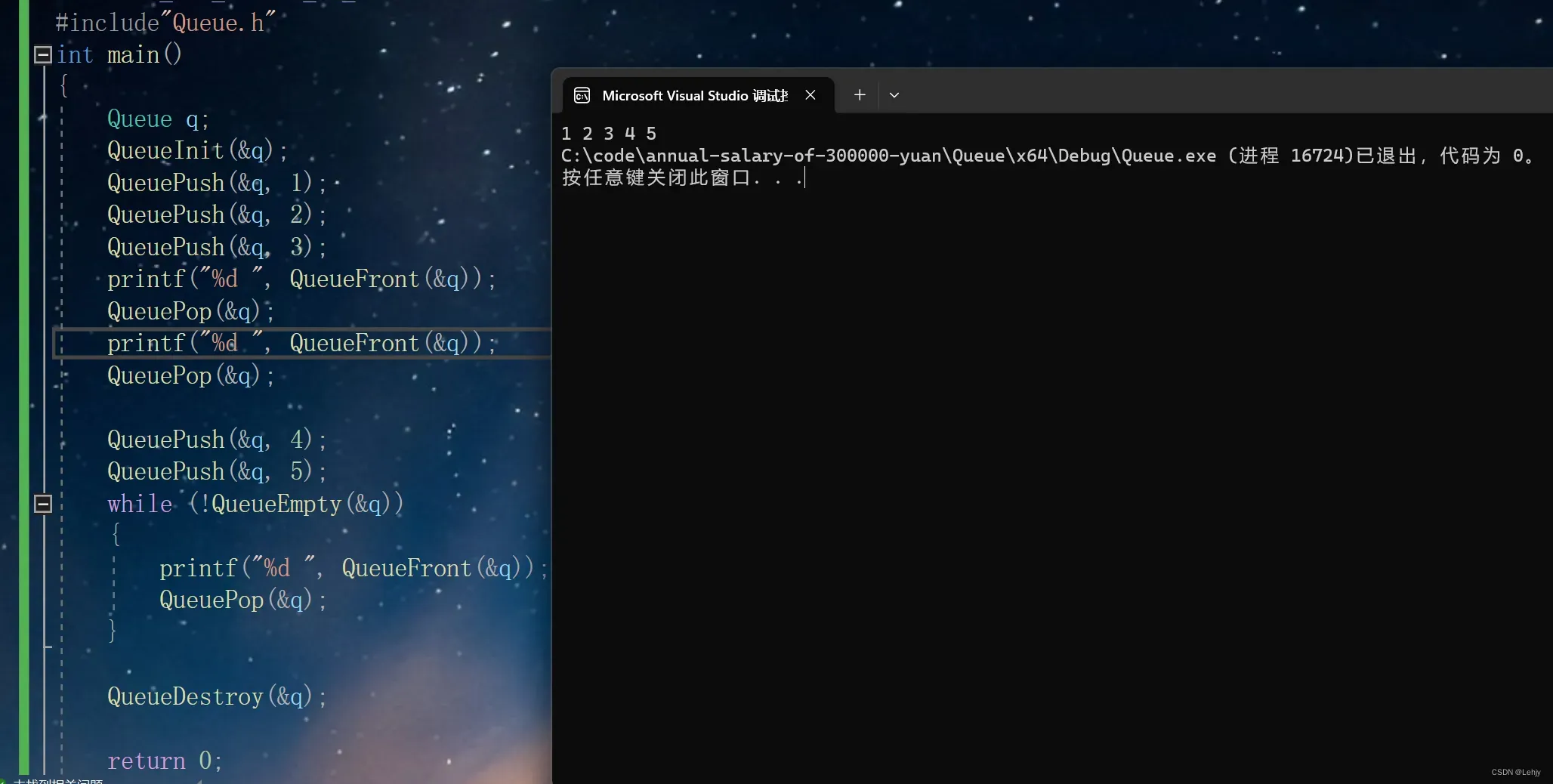前言:上次我们已经学习了数据结构中一个重要的线性表—栈,那么我们这一次就来学习另外一个重要的线性表—队列。

目录:
一、
队列的概念
二、
队列的实现:
1.队列的创建
三、
队列的操作
1.初始化队列
2.队尾入队列
3.队头出队列
4.获取队列头部元素
5.获取队列队尾元素
6.获取队列中有效元素个数
7.检测队列是否为空,如果为空返回非零结果,如果非空返回0
8.销毁队列
四、
完整代码展示
队列的概念
队列的概念及结构:队列:只允许在一端进行插入数据操作,在另一端进行删除数据操作的特殊线性表,队列具有先进先出FIFO(First In First Out) 入队列:进行插入操作的一端称为队尾 出队列:进行删除操作的一端称为队头。
队列的实现
队列也可以数组和链表的结构实现,使用链表的结构实现更优一些,因为如果使用数组的结构,出队列在数组头上出数据,效率会比较低。
我们用三个文件来完成对它的操作。
队列的创建:
typedef int QDataType;
// 链式结构:表示队列
typedef struct QueueNode
{
QDataType val;
struct QueueNode* next;
}QNode;
// 队列的结构
typedef struct Queue
{
QNode* phead;
QNode* ptail;
int size;
}Queue;
队列的实现:
队列的初始化:
void QueueInit(Queue* pq)
{
assert(pq);
pq->phead = pq->ptail = NULL;
pq->size = 0;
}
队列里的头和尾都为空。
队尾入队列:
void QueuePush(Queue* pq, QDataType x)
{
assert(pq);
QNode* newnode = (QNode*)malloc(sizeof(QNode));
if (newnode == NULL)
{
perror("malloc fail");
return;
}
newnode->val = x;
newnode->next = NULL;
if (pq->ptail == NULL)
{
pq->ptail = pq->phead = newnode;
}
else
{
pq->ptail->next = newnode;
pq->ptail = newnode;
}
pq->size++;
}
如果我们的队尾元素为空,那么我们的队尾就是newnode,如果我们的队尾不为空,我们的ptail的下一个指向newnode,现在的队尾就为newnode。
队头出队列:
void QueuePop(Queue* pq)
{
assert(pq);
//
assert(pq->phead);
QNode* del = pq->phead;
pq->phead = pq->phead->next;
free(del);
del = NULL;
if (pq->phead == NULL)
pq->ptail = NULL;
pq->size--;
}
如果我们直接删除队头元素那么我们就无法访问下一个元素,所以我们先把队头元素保存起来,让现在的队头元素为原来队头元素的下一个元素,在给原来的队头元素删除。
获取队列头部元素:
QDataType QueueFront(Queue* pq)
{
assert(pq);
//
assert(pq->phead);
return pq->phead->val;
}
获取队列队尾元素:
QDataType QueueBack(Queue* pq)
{
assert(pq);
//
assert(pq->ptail);
return pq->ptail->val;
}
获取队列中有效元素个数:
int QueueSize(Queue* pq)
{
assert(pq);
return pq->size;
}
size就是我们有效元素的个数,这里返回size就可以了。
检测队列是否为空,如果为空返回非零结果,如果非空返回0:
bool QueueEmpty(Queue* pq)
{
assert(pq);
return pq->phead == NULL;
}
队列为空返回0,不为空返回非0,后面测试代码的循环条件就是不为0,就输出,为0就跳出循环。
销毁队列:
void QueueDestroy(Queue* pq)
{
assert(pq);
QNode* cur = pq->phead;
while (cur)
{
QNode* next = cur->next;
free(cur);
cur = next;
}
pq->phead = pq->ptail = NULL;
pq->size = 0;
}
完整代码展示:
Queue.h:
#pragma once
#include<stdio.h>
#include<assert.h>
#include<stdlib.h>
#include<stdbool.h>
typedef int QDataType;
typedef struct QueueNode
{
QDataType val;
struct QueueNode* next;
}QNode;
typedef struct Queue
{
QNode* phead;
QNode* ptail;
int size;
}Queue;
void QueueInit(Queue* pq);
void QueueDestroy(Queue* pq);
void QueuePush(Queue* pq, QDataType x);
void QueuePop(Queue* pq);
QDataType QueueFront(Queue* pq);
QDataType QueueBack(Queue* pq);
bool QueueEmpty(Queue* pq);
int QueueSize(Queue* pq);
Queue.c:
#include"Queue.h"
void QueueInit(Queue* pq)
{
assert(pq);
pq->phead = pq->ptail = NULL;
pq->size = 0;
}
void QueueDestroy(Queue* pq)
{
assert(pq);
QNode* cur = pq->phead;
while (cur)
{
QNode* next = cur->next;
free(cur);
cur = next;
}
pq->phead = pq->ptail = NULL;
pq->size = 0;
}
void QueuePush(Queue* pq, QDataType x)
{
assert(pq);
QNode* newnode = (QNode*)malloc(sizeof(QNode));
if (newnode == NULL)
{
perror("malloc fail");
return;
}
newnode->val = x;
newnode->next = NULL;
if (pq->ptail == NULL)
{
pq->ptail = pq->phead = newnode;
}
else
{
pq->ptail->next = newnode;
pq->ptail = newnode;
}
pq->size++;
}
void QueuePop(Queue* pq)
{
assert(pq);
//
assert(pq->phead);
QNode* del = pq->phead;
pq->phead = pq->phead->next;
free(del);
del = NULL;
if (pq->phead == NULL)
pq->ptail = NULL;
pq->size--;
}
QDataType QueueFront(Queue* pq)
{
assert(pq);
//
assert(pq->phead);
return pq->phead->val;
}
QDataType QueueBack(Queue* pq)
{
assert(pq);
//
assert(pq->ptail);
return pq->ptail->val;
}
bool QueueEmpty(Queue* pq)
{
assert(pq);
return pq->phead == NULL;
}
int QueueSize(Queue* pq)
{
assert(pq);
return pq->size;
}
代码测试:
test.c:
#include"Queue.h"
int main()
{
Queue q;
QueueInit(&q);
QueuePush(&q, 1);
QueuePush(&q, 2);
QueuePush(&q, 3);
printf("%d ", QueueFront(&q));
QueuePop(&q);
printf("%d ", QueueFront(&q));
QueuePop(&q);
QueuePush(&q, 4);
QueuePush(&q, 5);
while (!QueueEmpty(&q))
{
printf("%d ", QueueFront(&q));
QueuePop(&q);
}
QueueDestroy(&q);
return 0;
}
这里我们先入队1,2,3,队头就是1,队尾就是3,我们在出队,先输出1,在把1出队,这样我们就访问2,在输出2之后把2出队,入队4,5,如果我们的队列不为0就输出3,4,5。最后输出的结果如下图:
相信大家一定可以完美的拿捏队列,感谢各位小伙伴的支持,我们下期再见!
文章出处登录后可见!



